Urbanization Changes the Composition of Airborne Fungi and Increases the Proportion of Fungal Allergens—A Case Study in Shanghai, China
Abstract
1. Introduction
2. Materials and Methods
2.1. Aerosol Collection
2.2. Air Mass Backward Trajectory and Auxiliary Data
2.3. DNA Extraction and qPCR Measurement
2.4. Sequencing Analysis
2.5. Statistical Analyses and Allergen Identification
3. Results and Discussion
3.1. Air Transport Paths and Land Use Types
3.2. Concentration of Airborne Fungi
3.3. Dominant Fungal Taxa
3.4. Fungal Community Diversity
3.5. Airborne Fungal Allergens
4. Conclusions
Supplementary Materials
Author Contributions
Funding
Institutional Review Board Statement
Informed Consent Statement
Data Availability Statement
Acknowledgments
Conflicts of Interest
Abbreviations
| TSPs | Total suspended particles |
| RH | Relative humidity |
| qPCR | Quantitative Polymerase Chain Reaction |
| ASVs | Amplicon sequence variants |
References
- Fröhlich-Nowoisky, J.; Kampf, C.J.; Weber, B.; Huffman, J.A.; Pöhlker, C.; Andreae, M.O.; Lang-Yona, N.; Burrows, S.M.; Gunthe, S.S.; Elbert, W.; et al. Bioaerosols in the Earth System: Climate, Health, and Ecosystem Interactions. Atmos. Res. 2016, 182, 346–376. [Google Scholar] [CrossRef]
- Blackwell, M. The Fungi: 1, 2, 3 … 5.1 Million Species? Am. J. Bot. 2011, 98, 426–438. [Google Scholar] [CrossRef] [PubMed]
- Hawksworth, D.L.; Lücking, R. Fungal Diversity Revisited: 2.2 to 3.8 Million Species. Microbiol. Spectr. 2017, 5. [Google Scholar] [CrossRef] [PubMed]
- Bongomin, F.; Gago, S.; Oladele, R.O.; Denning, D.W. Global and Multi-National Prevalence of Fungal Diseases-Estimate Precision. J. Fungi 2017, 3, 57. [Google Scholar] [CrossRef]
- Gabaldón, T.; Naranjo-Ortíz, M.A.; Marcet-Houben, M. Evolutionary Genomics of Yeast Pathogens in the Saccharomycotina. FEMS Yeast Res. 2016, 16, fow064. [Google Scholar] [CrossRef]
- Hassan, M.I.A.; Voigt, K. Pathogenicity Patterns of Mucormycosis: Epidemiology, Interaction with Immune Cells and Virulence Factors. Med. Mycol. 2019, 57, S245–S256. [Google Scholar] [CrossRef]
- Opulente, D.A.; Langdon, Q.K.; Buh, K.V.; Haase, M.A.B.; Sylvester, K.; Moriarty, R.V.; Jarzyna, M.; Considine, S.L.; Schneider, R.M.; Hittinger, C.T. Pathogenic Budding Yeasts Isolated Outside of Clinical Settings. FEMS Yeast Res. 2019, 19, foz032. [Google Scholar] [CrossRef]
- Singh-Babak, S.D.; Babak, T.; Fraser, H.B.; Johnson, A.D. Lineage-Specific Selection and the Evolution of Virulence in the Candida Clade. Proc. Natl. Acad. Sci. USA 2021, 118, e2016818118. [Google Scholar] [CrossRef]
- Denning, D.W.; O’Driscoll, B.R.; Hogaboam, C.M.; Bowyer, P.; Niven, R.M. The Link between Fungi and Severe Asthma: A Summary of the Evidence. Eur. Respir. J. 2006, 27, 615–626. [Google Scholar] [CrossRef]
- Arbes, S.J.; Gergen, P.J.; Elliott, L.; Zeldin, D.C. Prevalences of Positive Skin Test Responses to 10 Common Allergens in the US Population: Results from the Third National Health and Nutrition Examination Survey. J. Allergy Clin. Immunol. 2005, 116, 377–383. [Google Scholar] [CrossRef]
- Mari, A.; Schneider, P.; Wally, V.; Breitenbach, M.; Simon-Nobbe, B. Sensitization to Fungi: Epidemiology, Comparative Skin Tests, and Ige Reactivity of Fungal Extracts. Clin. Exp. Allergy 2003, 33, 1429–1438. [Google Scholar] [CrossRef] [PubMed]
- Pongracic, J.A.; O’Connor, G.T.; Muilenberg, M.L.; Vaughn, B.; Gold, D.R.; Kattan, M.; Morgan, W.J.; Gruchalla, R.S.; Smartt, E.; Mitchell, H.E. Differential Effects of Outdoor Versus Indoor Fungal Spores on Asthma Morbidity in Inner-City Children. J. Allergy Clin. Immunol. 2010, 125, 593–599. [Google Scholar] [CrossRef] [PubMed]
- Roy, S.; Chakraborty, A.; Maitra, S.; Bhattacharya, K. Monitoring of Airborne Fungal Spore Load in Relation to Meteorological Factors, Air Pollutants and Allergic Symptoms in Farakka, an Unexplored Biozone of Eastern India. Environ. Monit. Assess. 2017, 189, 370. [Google Scholar] [CrossRef]
- Baxi, S.N.; Sheehan, W.J.; Sordillo, J.E.; Muilenberg, M.L.; Rogers, C.A.; Gaffin, J.M.; Permaul, P.; Lai, P.S.; Louisias, M.; Petty, C.R.; et al. Association between Fungal Spore Exposure in Inner-City Schools and Asthma Morbidity. Ann. Allergy Asthma Immunol. 2019, 122, 610–615. [Google Scholar] [CrossRef]
- Chen, C.H.; Chao, J.; Chan, C.C.; Chen, B.Y.; Guo, Y.L. Current Asthma in Schoolchildren Is Related to Fungal Spores in Classrooms. Chest 2014, 146, 123–134. [Google Scholar] [CrossRef]
- Lewis, S.A.; Corden, J.M.; Forster, G.E.; Newlands, M. Combined Effects of Aerobiological Pollutants, Chemical Pollutants and Meteorological Conditions on Asthma Admissions and a & E Attendances in Derbyshire UK, 1993–1996. Clin. Exp. Allergy 2000, 30, 1724–1732. [Google Scholar]
- Tham, R.; Vicendese, D.; Dharmage, S.C.; Hyndman, R.J.; Newbigin, E.; Lewis, E.; O’Sullivan, M.; Lowe, A.J.; Taylor, P.; Bardin, P.; et al. Associations between Outdoor Fungal Spores and Childhood and Adolescent Asthma Hospitalizations. J. Allergy Clin. Immunol. 2017, 139, 1140–1147.e4. [Google Scholar] [CrossRef]
- Flies, E.J.; Clarke, L.J.; Brook, B.W.; Jones, P. Urbanisation Reduces the Abundance and Diversity of Airborne Microbes—But What Does That Mean for Our Health? A Systematic Review. Sci. Total Environ. 2020, 738, 140337. [Google Scholar] [CrossRef]
- Li, X.Y.; Chen, H.X.; Yao, M.S. Microbial Emission Levels and Diversities from Different Land Use Types. Environ. Int. 2020, 143, 105988. [Google Scholar] [CrossRef]
- Bowers, R.M.; Clements, N.; Emerson, J.B.; Wiedinmyer, C.; Hannigan, M.P.; Fierer, N. Seasonal Variability in Bacterial and Fungal Diversity of the near-Surface Atmosphere. Environ. Sci. Technol. 2013, 47, 12097–12106. [Google Scholar] [CrossRef] [PubMed]
- Liao, C.M.; Luo, W.C.; Chen, S.C.; Chen, J.W.; Liang, H.M. Temporal/Seasonal Variations of Size-Dependent Airborne Fungi Indoor/Outdoor Relationships for a Wind-Induced Naturally Ventilated Airspace. Atmos. Environ. 2004, 38, 4415–4419. [Google Scholar] [CrossRef]
- Oliveira, M.; Ribeiro, H.; Abreu, I. Annual Variation of Fungal Spores in Atmosphere of Porto: 2003. Ann. Agric. Environ. Med. 2005, 12, 309–315. [Google Scholar] [PubMed]
- Yamamoto, N.; Bibby, K.; Qian, J.; Hospodsky, D.; Rismani-Yazdi, H.; Nazaroff, W.W.; Peccia, J. Particle-Size Distributions and Seasonal Diversity of Allergenic and Pathogenic Fungi in Outdoor Air. ISME J. 2012, 6, 1801–1811. [Google Scholar] [CrossRef] [PubMed]
- Burch, M.; Levetin, E. Effects of Meteorological Conditions on Spore Plumes. Int. J. Biometeorol. 2002, 46, 107–117. [Google Scholar]
- Núñez, A.; de Paz, G.A.; Rastrojo, A.; García, A.M.; Alcamí, A.; Gutiérrez-Bustillo, A.M.; Moreno, D.A. Monitoring of Airborne Biological Particles in Outdoor Atmosphere. Part 1: Importance, Variability and Ratios. Int. Microbiol. 2016, 19, 1–13. [Google Scholar]
- Wu, J.; Cunanan, J.; Kim, L.; Kulatunga, T.; Huang, C.; Anekella, B. Stability of Genomic DNA at Various Storage Conditions. In Proceedings of the International Society for Biological and Environmental Repositories 2009 Annual Meeting, Portland, OR, USA, 12–15 May 2009; Volume 12. [Google Scholar]
- Xu, C.H.; Chen, H.; Liu, Z.; Sui, G.D.; Li, D.; Kan, H.D.; Zhao, Z.H.; Hu, W.; Chen, J.M. The Decay of Airborne Bacteria and Fungi in a Constant Temperature and Humidity Test Chamber. Environ. Int. 2021, 157, 106816. [Google Scholar] [CrossRef]
- Ramakodi, M.P. A Comprehensive Evaluation of Single-End Sequencing Data Analyses for Environmental Microbiome Research. Arch. Microbiol. 2021, 203, 6295–6302. [Google Scholar] [CrossRef]
- Callahan, B.J.; McMurdie, P.J.; Rosen, M.J.; Han, A.W.; Johnson, A.J.A.; Holmes, S.P. Dada2: High-Resolution Sample Inference from Illumina Amplicon Data. Nat. Methods 2016, 13, 581–582. [Google Scholar] [CrossRef]
- Breitenbach, M. The Spectrum of Fungal Allergy. Int. Arch. Allergy Immunol. 2008, 145, 58–86. [Google Scholar]
- Jones, A.M.; Harrison, R.M. The Effects of Meteorological Factors on Atmospheric Bioaerosol Concentrations—A Review. Sci. Total Environ. 2004, 326, 151–180. [Google Scholar] [CrossRef] [PubMed]
- Gao, M.; Yan, X.; Qiu, T.L.; Han, M.L.; Wang, X.M. Variation of Correlations between Factors and Culturable Airborne Bacteria and Fungi. Atmos. Environ. 2016, 128, 10–19. [Google Scholar] [CrossRef]
- Li, Y.P.; Fu, H.L.; Wang, W.; Liu, J.; Meng, Q.L.; Wang, W.K. Characteristics of Bacterial and Fungal Aerosols during the Autumn Haze Days in Xi’an, China. Atmos. Environ. 2015, 122, 439–447. [Google Scholar] [CrossRef]
- Reponen, T.; Willeke, K.; Ulevicius, V.; Reponen, A.; Grinshpun, S.A. Effect of Relative Humidity on the Aerodynamic Diameter and Respiratory Deposition of Fungal Spores. Atmos. Environ. 1996, 30, 3967–3974. [Google Scholar] [CrossRef]
- Agarwal, M.K.; Shivpuri, D.N.; Mukerji, K.G. Studies on Allergenic Fungal Spores of Delhi, India, Metropolitan Area—Botanical Aspects (Aeromycology). J. Allergy 1969, 44, 193–203. [Google Scholar] [CrossRef]
- Chakrabarti, H.S.; Das, S.; Gupta-Bhattacharya, S. Outdoor Airborne Fungal Spora Load in a Suburb of Kolkata, India: Its Variation, Meteorological Determinants and Health Impact. Int. J. Environ. Health Res. 2012, 22, 37–50. [Google Scholar] [CrossRef]
- Garaga, R.; Avinash, C.K.R.; Kota, H. Seasonal Variation of Airborne Allergenic Fungal Spores in Ambient PM10 -a Study in Guwahati, the Largest City of North-East India. Air Qual. Atmos. Health 2019, 12, 11–20. [Google Scholar] [CrossRef]
- Kumar, A.; Attri, A.K. Characterization of Fungal Spores in Ambient Particulate Matter: A Study from the Himalayan Region. Atmos. Environ. 2016, 142, 182–193. [Google Scholar] [CrossRef]
- Liu, Y.; Zhang, Y.Y.; Shi, Y.T.; Shen, F.X.; Yang, Y.; Wang, M.J.; Zhang, G.Y.; Deng, T.; Lai, S.C. Characterization of Fungal Aerosol in a Landfill and an Incineration Plants in Guangzhou, Southern China: The Link to Potential Impacts. Sci. Total Environ. 2021, 764, 142908. [Google Scholar] [CrossRef]
- Gou, H.E.; Lu, J.J.; Li, S.M.; Tong, Y.B.; Xie, C.B.; Zheng, X.W. Assessment of Microbial Communities in PM1 and PM10 of Urumqi during Winter. Environ. Pollut. 2016, 214, 202–210. [Google Scholar] [CrossRef]
- Stalder, T.; Barraud, O.; Casellas, M.; Dagot, C.; Ploy, M.C. Integron Involvement in Environmental Spread of Antibiotic Resistance. Front. Microbiol. 2012, 3, 119. [Google Scholar] [CrossRef]
- Fröhlich-Nowoisky, J.; Pickersgill, D.A.; Després, V.R.; Pöschl, U. High Diversity of Fungi in Air Particulate Matter. Proc. Natl. Acad. Sci. USA 2009, 106, 12814–12819. [Google Scholar] [CrossRef] [PubMed]
- Hibbett, D.S.; Binder, M.; Bischoff, J.F.; Blackwell, M.; Cannon, P.F.; Eriksson, O.E.; Huhndorf, S.; James, T.; Kirk, P.M.; Lücking, R.; et al. A Higher-Level Phylogenetic Classification of the Fungi. Mycol. Res. 2007, 111, 509–547. [Google Scholar] [CrossRef] [PubMed]
- Grinn-Gofron, A.; Bosiacka, B. Effects of Meteorological Factors on the Composition of Selected Fungal Spores in the Air. Aerobiologia 2015, 31, 63–72. [Google Scholar] [CrossRef]
- Abel-Fernández, E.; Martínez, M.J.; Galán, T.; Pineda, F. Going over Fungal Allergy: Alternaria alternata and Its Allergens. J. Fungi 2023, 9, 582. [Google Scholar] [CrossRef] [PubMed]
- Lee, W.; Kim, D.G.; Perera, R.H.; Kim, J.S.; Cho, Y.; Lee, J.W.; Seo, C.W.; Lim, Y.W. Diversity of Nigrospora (Xylariales, Apiosporaceae) Species Identified in Korean Macroalgae Including Five Unrecorded Species. Mycobiology 2023, 51, 401–409. [Google Scholar] [CrossRef]
- Pose, G.; Patriarca, A.; Kyanko, V.; Pardo, A.; Pinto, V.F. Water Activity and Temperature Effects on Mycotoxin Production by Alternaria alternata on a Synthetic Tomato Medium. Int. J. Food Microbiol. 2010, 142, 348–353. [Google Scholar] [CrossRef]
- Kasprzyk, I.; Sulborska, A.; Nowak, M.; Szymanska, A.; Kaczmarek, J.; Haratym, W.; Weryszko-Chmielewska, E.; Jedryczka, M. Fluctuation Range of the Concentration of Airborne Alternaria conidiospores Sampled at Different Geographical Locations in Poland (2010–2011). Acta Agrobot. 2013, 66, 65–76. [Google Scholar] [CrossRef][Green Version]
- Rinu, K.; Malviya, M.K.; Sati, P.; Tiwari, S.C.; Pandey, A. Response of cold-tolerant Aspergillus spp. to solubilization of Fe and Al phosphate in presence of different nutritional sources. ISRN Soil Sci. 2013, 2013, 598541. [Google Scholar] [CrossRef]
- Santl-Temkiv, T.; Amato, P.; Casamayor, E.O.; Lee, P.K.H.; Pointing, S.B. Microbial Ecology of the Atmosphere. FEMS Microbiol. Rev. 2022, 46, fuac009. [Google Scholar] [CrossRef]
- Horner, W.E.; Helbling, A.; Salvaggio, J.E.; Lehrer, S.B. Fungal Allergens. Clin. Microbiol. Rev. 1995, 8, 161–179. [Google Scholar] [CrossRef]
- Vijay, H.M.; Kurup, V.P. Fungal Allergens. Clin. Allergy Immunol. 2004, 18, 223–249. [Google Scholar] [PubMed]
- Kurup, V.P.; Banerjee, B. Fungal Allergens and Peptide Epitopes. Peptides 2000, 21, 589–599. [Google Scholar] [CrossRef] [PubMed]
- Terr, A.I. Are Indoor Molds Causing a New Disease? J. Allergy Clin. Immunol. 2004, 113, 221–226. [Google Scholar] [CrossRef] [PubMed]


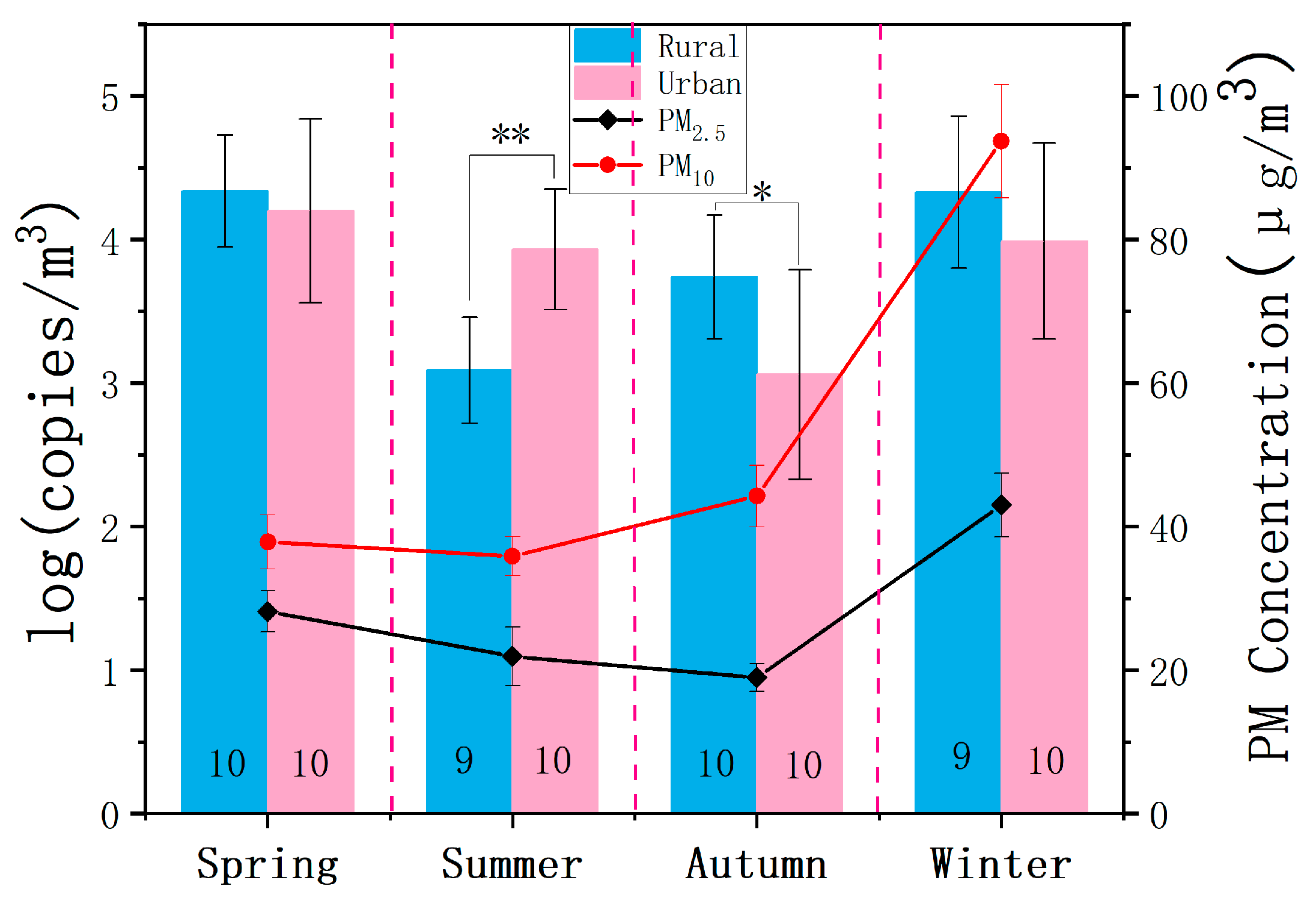
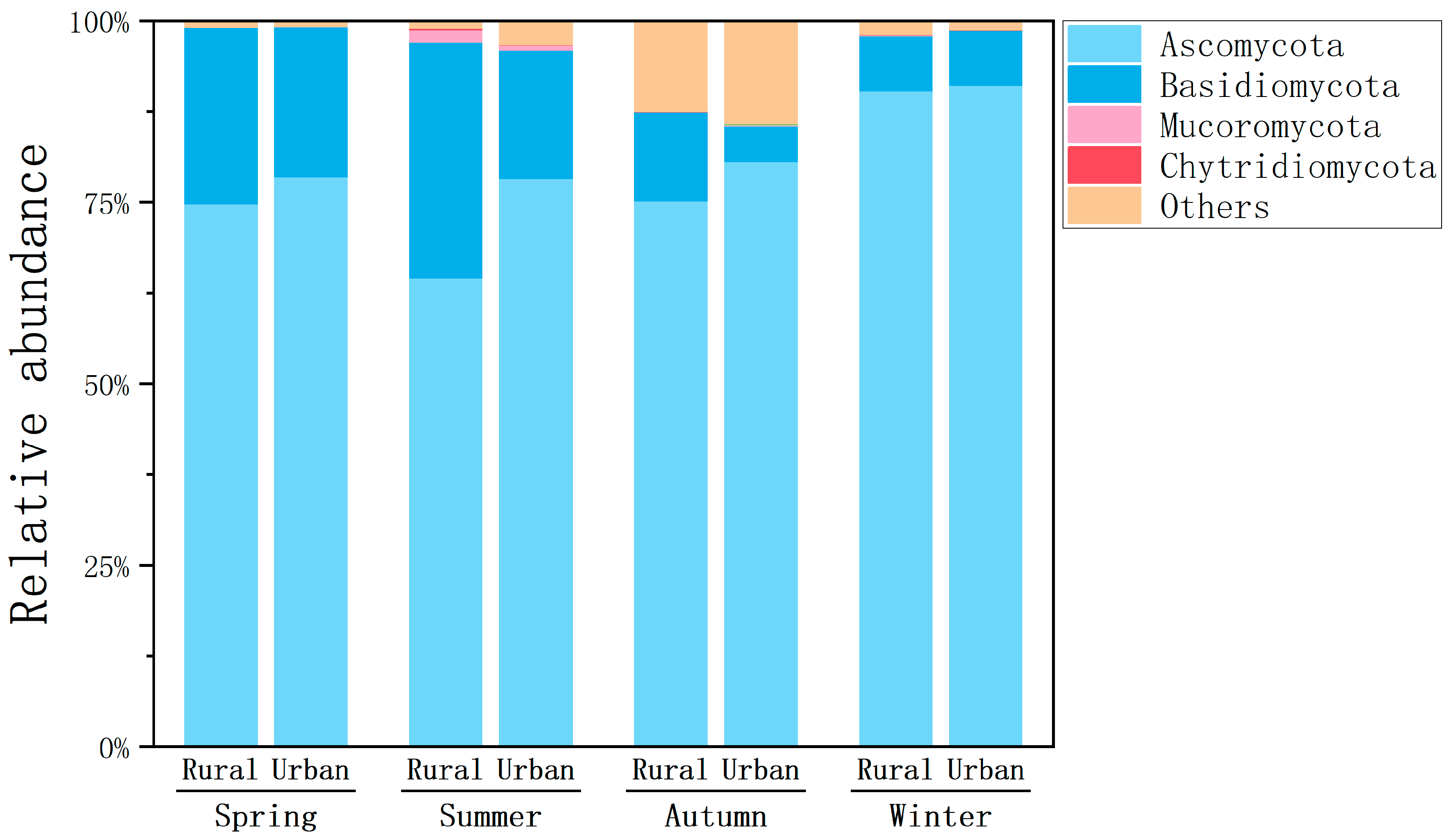
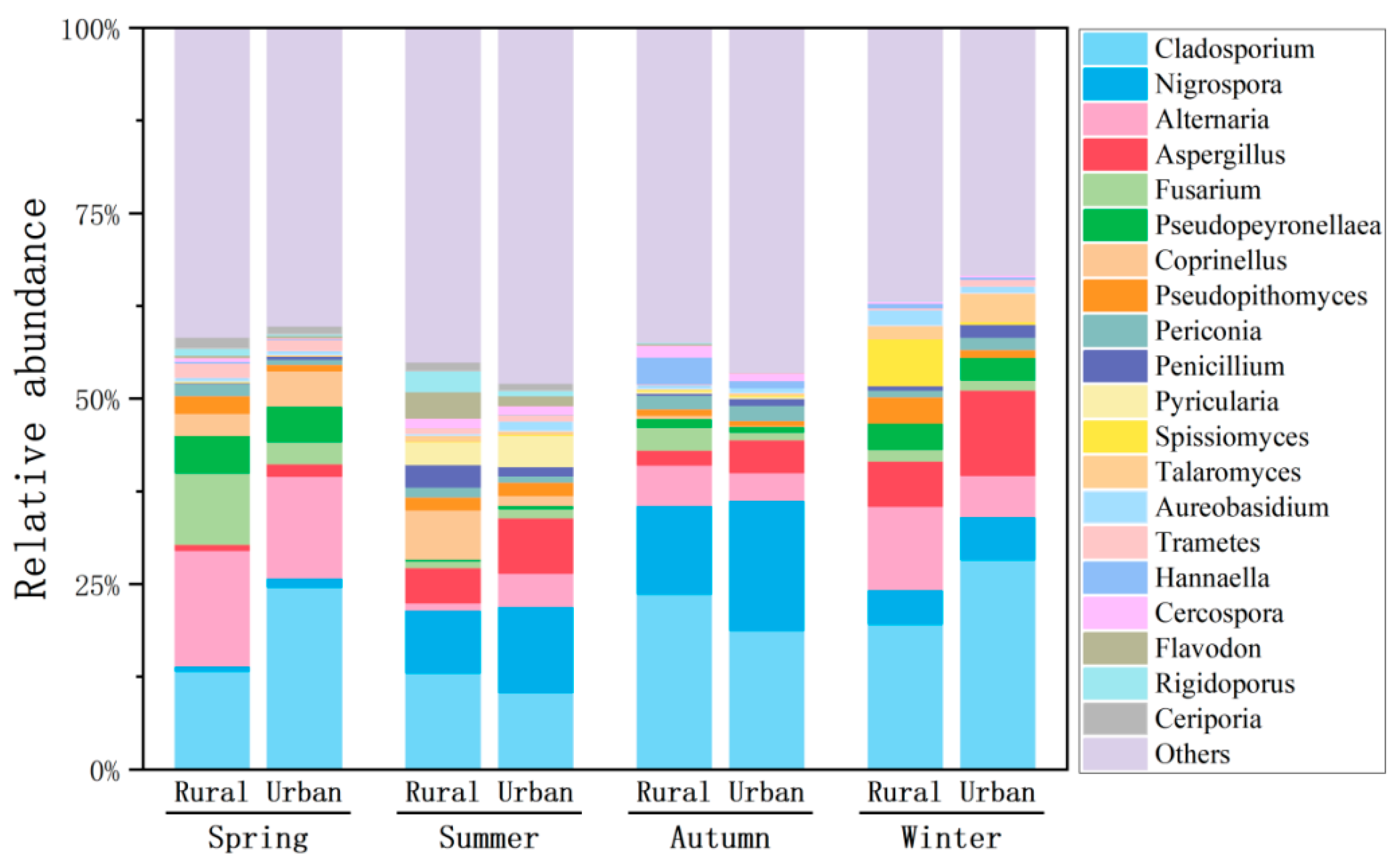

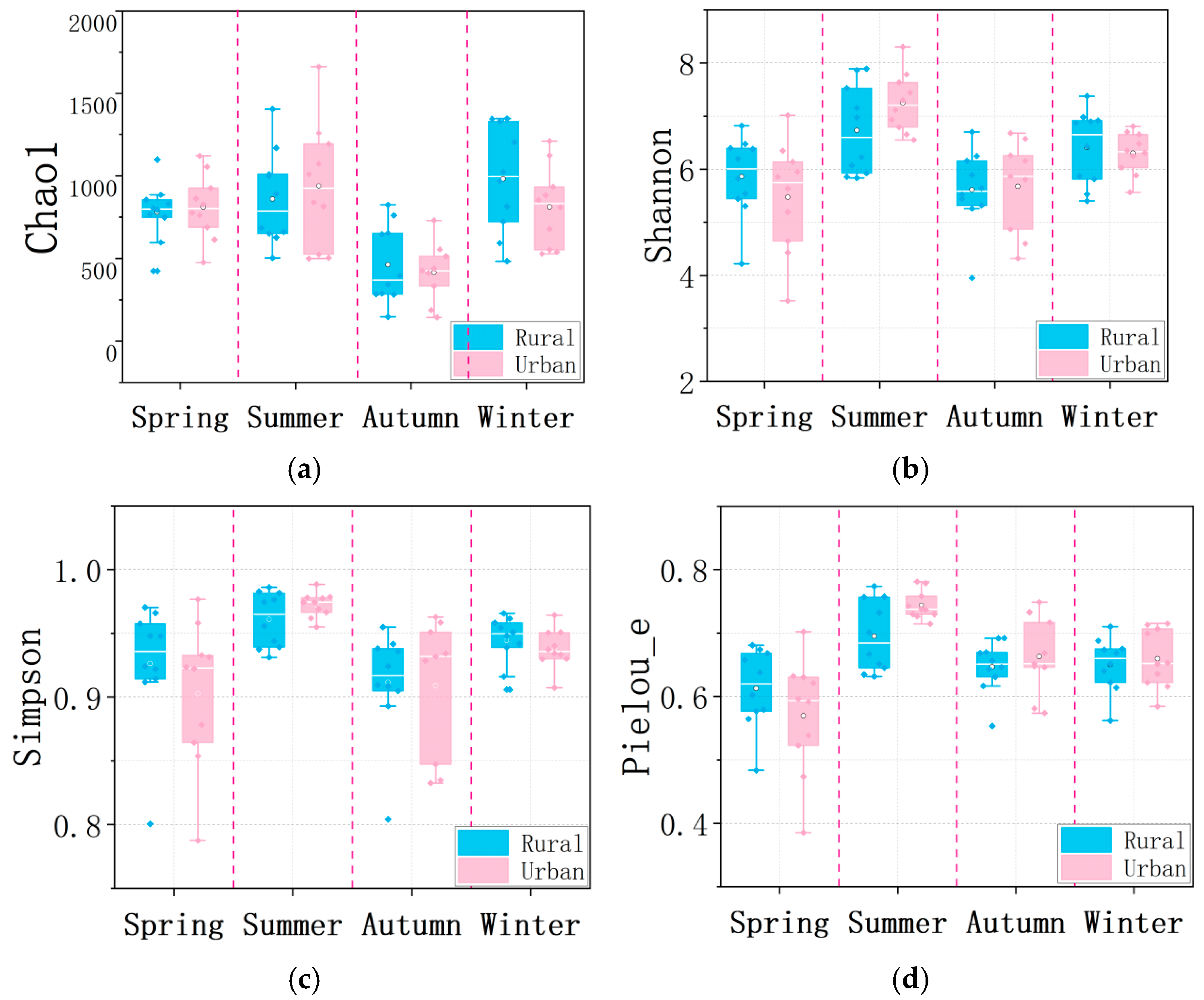
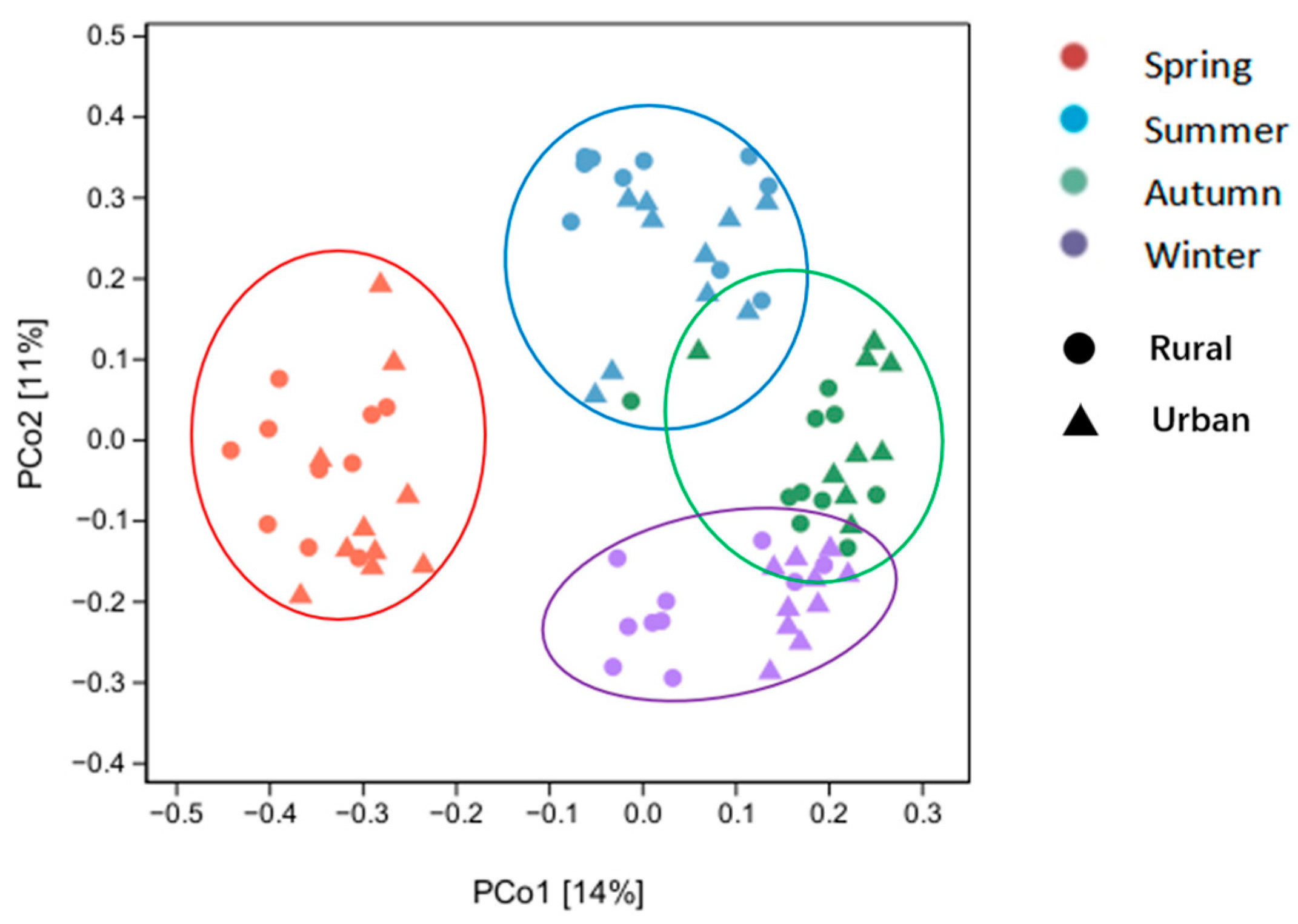

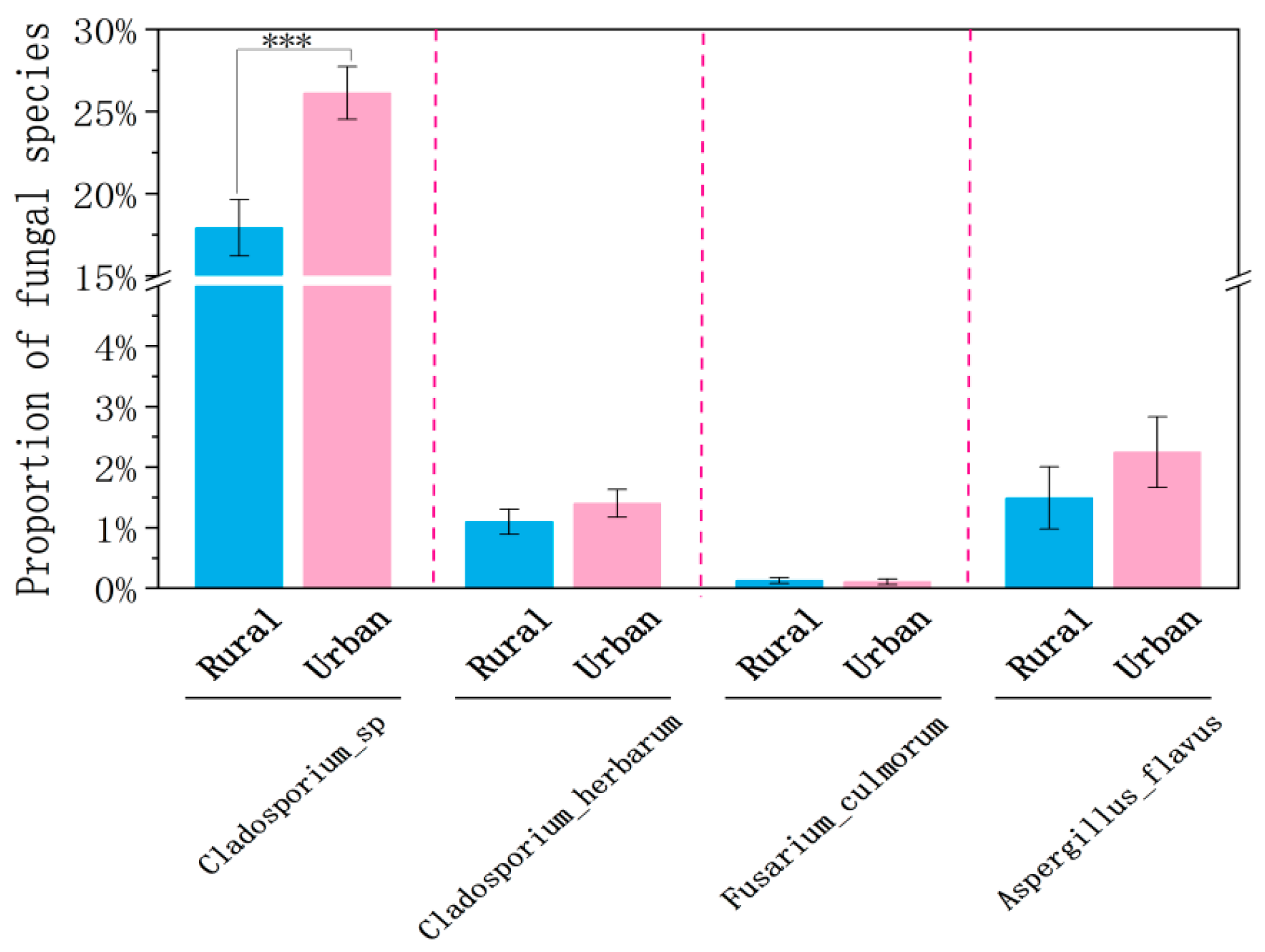
Disclaimer/Publisher’s Note: The statements, opinions and data contained in all publications are solely those of the individual author(s) and contributor(s) and not of MDPI and/or the editor(s). MDPI and/or the editor(s) disclaim responsibility for any injury to people or property resulting from any ideas, methods, instructions or products referred to in the content. |
© 2025 by the authors. Licensee MDPI, Basel, Switzerland. This article is an open access article distributed under the terms and conditions of the Creative Commons Attribution (CC BY) license (https://creativecommons.org/licenses/by/4.0/).
Share and Cite
Yan, K.; Chen, Y.; Zhao, M.; Li, Y.; He, J. Urbanization Changes the Composition of Airborne Fungi and Increases the Proportion of Fungal Allergens—A Case Study in Shanghai, China. Atmosphere 2025, 16, 641. https://doi.org/10.3390/atmos16060641
Yan K, Chen Y, Zhao M, Li Y, He J. Urbanization Changes the Composition of Airborne Fungi and Increases the Proportion of Fungal Allergens—A Case Study in Shanghai, China. Atmosphere. 2025; 16(6):641. https://doi.org/10.3390/atmos16060641
Chicago/Turabian StyleYan, Ke, Ying Chen, Mingtao Zhao, Yifei Li, and Jiaxin He. 2025. "Urbanization Changes the Composition of Airborne Fungi and Increases the Proportion of Fungal Allergens—A Case Study in Shanghai, China" Atmosphere 16, no. 6: 641. https://doi.org/10.3390/atmos16060641
APA StyleYan, K., Chen, Y., Zhao, M., Li, Y., & He, J. (2025). Urbanization Changes the Composition of Airborne Fungi and Increases the Proportion of Fungal Allergens—A Case Study in Shanghai, China. Atmosphere, 16(6), 641. https://doi.org/10.3390/atmos16060641





